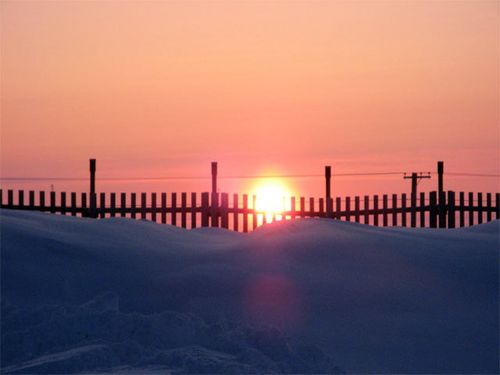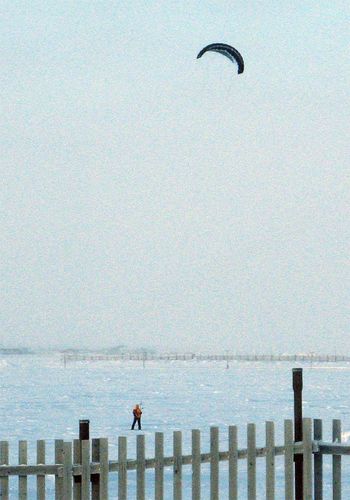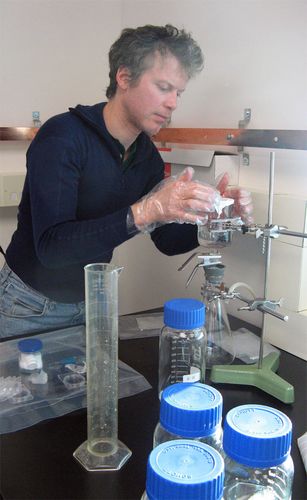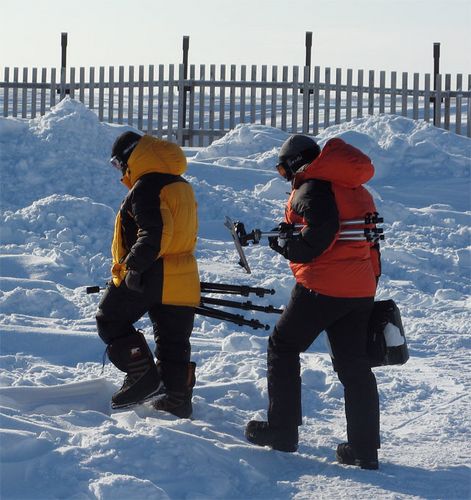I am learning that there are so many different projects and types of science going on around me, that I have to take my time in getting my head around it all. It is really incredible to see so many scientists working hard all day and night. They are gathering as much data as they can here, and many are taking home samples to further analyze with different equipment at home. It is not possible to have everything shipped to Barrow, so they are doing what they can in the field with lots more work to follow at home. It is amazing to see the collaboration between so many different groups and countries and to realize that this is going to continue long after they all leave Barrow.
 Sunrise on My Walk into Work at BARC.
Sunrise on My Walk into Work at BARC.
Record-keeping is an extremely important piece of any scientific endeavor. Every scientist keeps a field notebook to write in while outside. That information is later duplicated into other forms including notebooks, logbooks, and computer databases. It's very important that detailed records are kept and then stored in many places. I would be in heaven if all my 7th graders would treat their hard work the same way!
Several scientists are measuring the snow to see what absorbs light in it. Harry Beine is measuring the soluble (dissolved) species in the snow. He is interested in things like nitrates and hydrogen peroxide. Today I learned to analyze the samples Harry and I have been taking. It was fun operating the UV VIS Spectrometer in the laboratory. In between preparing the next sample and waiting for the current sample to run, I was able to look out the window and watch some kite snowboarders bouncing around on the hard tundra. It looked like it was a lot rougher and colder ride than the kite boarders have in the ocean in San Diego. After all the analysis was done for the day we started our dishwashing procedure. It takes a lot of steps to get the sample bottles clean and contaminant free before we can use them again.
 A person kite snowboarding near BARC.
A person kite snowboarding near BARC.
Didier Voisin and his group are looking at what is not soluble in the snow. He filters the melted snow and then carefully labels and packs away the filters to analyze at home in France. In his home lab he will burn the residue left on the filter. The final analysis will show the composition of elemental and organic carbon in the sample.
 Filtering out insoluble material from melted snow samples.
Filtering out insoluble material from melted snow samples.
Holly Reay and James France are studying the snow while they are out in it. They are usually hunkered down in the snow field with all of their equipment. They measure the general absorbance of the snow to determine the optical properties of the snow. Another measurement they perform is light albedo which shows how much light the snow reflects. Lastly, they look at the stratigraphy of the snow. My seventh grade students look at stratigraphy in different geology assignments to determine types and ages of rock. Holly and James look at the stratigraphy of the snow because light penetrates differently in the various layers. While they have the snow pit cleared out, Didier Voisin takes samples from the same area to analyze it for carbon.
 Holly Reay (bottom) and James France (top) heading off to work in the snow field
Holly Reay (bottom) and James France (top) heading off to work in the snow field
I managed to stay awake and delay my nightly shower until 10:30 PM when twilight was just ending. (I didn't want to go outside with wet hair.) I snuck around the corner from our hut and looked at the stars that were visible. Unfortunately there are too many improperly shielded lights around BASC and the lights from the community of Barrow are very bright. It's not very easy to get a good dark sky without a very long walk in -30°C weather. (A January Star Party in Tucson is looking better all the time!) Last night I saw Orion's Belt and would label it at a magnitude 3 in the Globe at Night program. Venus was still up. Polaris was about 7 fists above the horizon, almost directly overhead! Sirius, Castor, Pollux, Taurus, and Saturn were visible also. One night I will set my alarm clock to wake up for the aurora or I may just take my sleeping bag and camp at the BARC to wait for them, since the skies are darker there.

